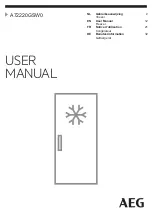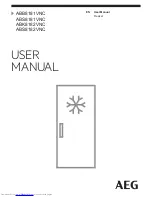
EN -10-
Defrosting
Freezer defrosting process
• Small amounts of frost will accumulate inside the freezer, depending upon the length of
time for which the door is left open or the amount of moisture introduced. It is essential to
ensure that no frost or ice is allowed to form at places where it will affect the close fitting
of the door seal. This might allow air to penetrate the cabinet, encouraging continuous
running of the compressor. Thin frost formation is quite soft and can be removed with
a brush or plastic scraper. Do not use metal or sharp scrapers, mechanical devices or
other means to accelerate the defrosting process. Remove all dislodged frost from the
cabinet floor. It is not necessary to switch off the appliance for the removal of this frost.
• For the removal of heavy ice deposits, disconnect the appliance from the mains supply,
empty the contents into cardboard boxes and wrap in thick blankets or layers of paper to
keep them cold. Defrosting will be most effective if carried out when the freezer is nearly
empty and should be carried out as quickly as possible to prevent undue increase in the
temperature of the contents.
• Do not use metal or sharp scrapers, mechanical devices or other means to accelerate
the defrosting process. An increase in temperature of frozen food during defrosting will
shorten the storage life. If the contents are well wrapped and placed in a cool area they
should keep for several hours.
• Dry the inside of the compartment
with a sponge or a clean cloth.
• To accelerate the defrosting
process, place one or more bowls
of warm water in the freezer
compartment.
• Examine the contents when replacing them in the freezer and if some of the food has
thawed out it should be eaten within 24 hours, or be cooked and re-frozen.
• After defrosting has finished clean the inside of the appliance with a solution of warm
water with a little bicarbonate of soda and then dry thoroughly. Wash all removable parts
in the same way and reassemble. Reconnect the appliance to the mains supply and
leave for 2 to 3 hours on setting « 5 » position before introducing the food back into the
freezer.
TRANSPORTATION AND CHANGING OF
INSTALLATION POSITION
PART 5.
Transportation and changing of Installation position
• The original packages and foamed polystyrene (PS) can be retained if required.
• During transportation, the appliance should be secured with a wide string or a strong
rope. The instructions written on the corrugated box must be followed while transporting.
• Before transporting or changing the installation position,
all the moving objects (ie, ice tray, scraper, drawers …)
should be taken out or fixed with bands in order to prevent
them from getting damaged.
!
Carry your fridge in the upright position.
Summary of Contents for 8606108649794
Page 26: ...MK 26 27 29 30 30 31 32 32 32 33 34 35 36 36 36 37 38 39...
Page 27: ...MK 27 R600 1...
Page 28: ...MK 28 16 8 2000 m...
Page 29: ...MK 29 WEEE...
Page 30: ...MK 30 220 240 50...
Page 31: ...MK 31 3 50 5 2 90 condenser from touching the wall...
Page 32: ...MK 32 24 5 1 5 1 1 2 3 4 5 2 4 24 24 5 2...
Page 33: ...MK 33 10 C 43 C o C T 16 43 o C ST 16 38 o C N 16 32 o C SN 10 32 o C 3 o 24 3...
Page 34: ...MK 34 4...
Page 35: ...MK 35 24 2 3 5...
Page 36: ...MK 36 5...
Page 37: ...MK 37 1 6...
Page 38: ...MK 38 1 2 3 4 5 6...
Page 39: ...MK 39 1 2 3 4 5 6 7 2 1 3 4 5 6 7 7...
Page 65: ...52228883...











































